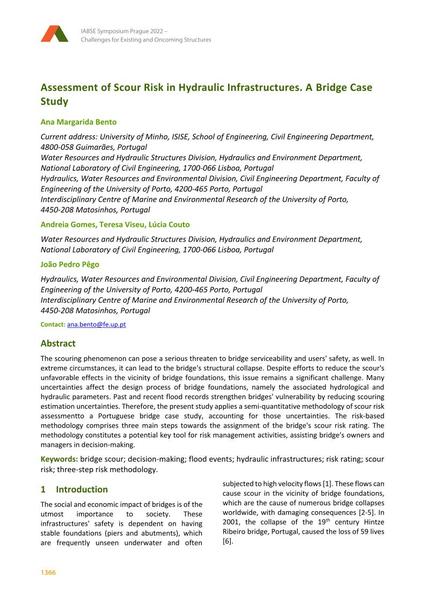Assessment of Scour Risk in Hydraulic Infrastructures. A Bridge Case Study

|
|
|||||||||||
Bibliographic Details
| Author(s): |
Ana Margarida Bento
(Water Resources and Hydraulic Structures Division, Hydraulics and Environment Department,
National Laboratory of Civil Engineering, 1700-066 Lisboa, Portugal)
Andreia Gomes (Water Resources and Hydraulic Structures Division, Hydraulics and Environment Department, National Laboratory of Civil Engineering, 1700-066 Lisboa, Portugal) Teresa Viseu (Water Resources and Hydraulic Structures Division, Hydraulics and Environment Department, National Laboratory of Civil Engineering, 1700-066 Lisboa, Portugal) Lúcia Couto (Water Resources and Hydraulic Structures Division, Hydraulics and Environment Department, National Laboratory of Civil Engineering, 1700-066 Lisboa, Portugal) João Pedro Pêgo (Hydraulics, Water Resources and Environmental Division, Civil Engineering Department, Faculty of Engineering of the University of Porto, 4200-465 Porto, Portugal) |
||||
|---|---|---|---|---|---|
| Medium: | conference paper | ||||
| Language(s): | English | ||||
| Conference: | IABSE Symposium: Challenges for Existing and Oncoming Structures, Prague, Czech Republic, 25-27 May 2022 | ||||
| Published in: | IABSE Symposium Prague 2022 | ||||
|
|||||
| Page(s): | 1366-1373 | ||||
| Total no. of pages: | 8 | ||||
| DOI: | 10.2749/prague.2022.1366 | ||||
| Abstract: |
The scouring phenomenon can pose a serious threaten to bridge serviceability and users' safety, as well. In extreme circumstances, it can lead to the bridge's structural collapse. Despite efforts to reduce the scour's unfavorable effects in the vicinity of bridge foundations, this issue remains a significant challenge. Many uncertainties affect the design process of bridge foundations, namely the associated hydrological and hydraulic parameters. Past and recent flood records strengthen bridges' vulnerability by reducing scouring estimation uncertainties. Therefore, the present study applies a semi-quantitative methodology of scour risk assessmentto a Portuguese bridge case study, accounting for those uncertainties. The risk-based methodology comprises three main steps towards the assignment of the bridge's scour risk rating. The methodology constitutes a potential key tool for risk management activities, assisting bridge's owners and managers in decision-making. |
||||
| Keywords: |
bridge scour decision-making flood events hydraulic infrastructures risk rating scour risk three-step risk methodology
|
||||
| Copyright: | © 2022 International Association for Bridge and Structural Engineering (IABSE) | ||||
| License: | This creative work is copyrighted material and may not be used without explicit approval by the author and/or copyright owner. |
||||
